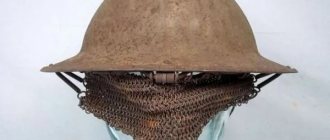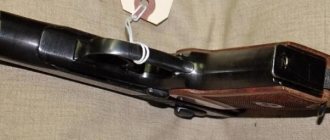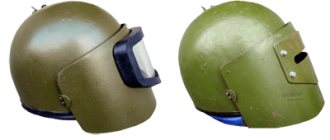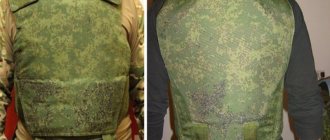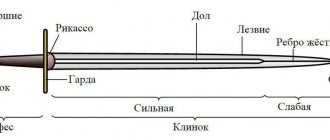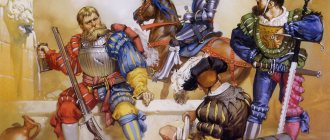Prehistoric Helmets (Archaic)
In ancient times, the Greeks called helmets with a word that meant a hat made of dog skin - κυνέη (literally “dog”). In Homer's Iliad, the word κυνέη refers to both a hat and any helmet, leather or metal, but without a forehead, plume and cheek pads. Homer calls copper helmets with cheekpieces and a plume of horsehair the word κόρυς. In origin, κόρυς is related to the word κέρας, “horn,” and perhaps the helmets were so called because of the presence of decorations in the form of horns or a specially shaped plume.
Herodotus, describing the robes and weapons of the Persian army, speaks of fox hats (helmets?) on the heads of the Thracians. He also mentions the leather helmets of other tribes. This means that at the beginning of the 5th century BC. e. such helmets were not exotic. Hats made of felt, skins and leather were reinforced with iron plates, bones, fangs, wood or any other durable material that did not require special craft skills. Later, bronze plates began to be bent to the shape of the head, covering a lining made of the same felt and leather. The helmets of the heroes of the Trojan War, created by non-Greeks, were very different from those that the Greeks painted six centuries later on vases, and consisted of four plates.
Due to its primitive design, the composite helmet has reached our time from antiquity in just a couple of copies. The first all-metal helmets appeared in Greece in the 15th century BC. The Heraklion Museum on Crete displays a partially preserved bronze helmet with elongated cheekpieces and a dome pointed upward with a pommel for attaching a horsetail plume.
After the Trojan War (at the turn of the 13th-12th centuries BC), a migration of peoples took place. The “dark” ages began in Hellas, and the Greek tribes even lost writing, not to mention craft skills. The first bronze helmets found in Hellas from the 1st millennium BC date back to the 8th century BC. e. and reproduce the shape of Assyrian helmets with a rectangular cutout for the face, formed by wide triangular cheekpieces, a pointed dome and a high pommel with decoration in the form of a bronze arch. Conventionally, such helmets are called conical. After the disappearance of the pommel and the smoothing of the dome to a hemispherical shape, the appearance of the helmet approaches the Illyrian type.
Helmet from a burial in the Peloponnese (Greece). The leather part was added during restoration. 11th century BC e.
Conical helmet from the Archaeological Museum of Argos. 11th-8th century BC
Late Middle Ages
Appearance at the beginning of the 14th century. firearms, became a turning point in the history of chivalry. Heavy armor lost its importance because it could not effectively withstand bullets, while preventing its owners from escaping from them. Helmets were not abandoned, only their appearance and design were changed. Since warriors needed maximum visibility during battle, headbands began to be made open, but with a visor - a movable element that, if necessary, was lowered over the eyes and upper part of the face.
Bascinet
The model, originally worn under the kybelhelm, was worn at the end of the 14th century. became a completely independent part of knightly armor. The bascinet was transformed, making the back wall almost vertical (in Italian samples), and later generally bending it at an acute angle.
There are several variations, depending on the design and type of visor.
- Hundsgugel means “dog hood” in German. A strongly extended forward cone-shaped visor with ventilation holes, reminiscent of a hound's muzzle. The increased space in the nose area made breathing easier during combat.
- Klappvisor - a flat visor with fastening not on both sides of the helmet, but in the middle in the forehead area. The model was used in the German army.
- Large bascinet - in addition to the elongated visor, it was equipped with a reinforced collar with a chin, replacing the ineffective aventail.
Salad
A modification of the bascinet, shaped like a hat or helmet with an elongated, developed back plate. Additionally, it was equipped with a stiffening rib, which in some versions “grew” into a ridge. Appearing in Italy, salad (celata) quickly gained popularity in France and Germany.
The Venetian variety is called barbute. This is a cross between a classic salad and a Corinthian helmet of the ancient Greeks. The barbuta was made in one piece with developed cheekpieces that left only the nose and lips open.
In the 15th century Salads became the predominant head armor in Germany. And a few centuries later they were revived in the form of German helmets from the Wehrmacht era.
Armet
Cavalry knight's helmet of the late Middle Ages and Modern times. It has the most advanced design in terms of protection. It was originally made by Milanese craftsmen, and then became widespread throughout Italy and beyond.
Distinctive features:
- two visors in the shape of a sparrow's beak, which could “open” for better visibility and air flow;
- chinrest made of movable flaps;
- a special occipital disc - rondel, covering the strap of the lower visor;
- spherical dome;
- tight fit to the head with additional protection of the neck and collarbone area;
- the breathing slits are not round, but elongated;
In the 16th century Armets began to be divided into tournament and combat. In the latter, the viewing slits were made higher.
Stechhelm
The gradual abolition of knighthood as a combat unit and the increase in the importance of tournaments, which became a tribute to tradition, led to the appearance of one of the most bizarre helmets, called Stechhelm (“protection from a piercing spear”). The second name “Toad Head” very accurately describes the shape of this armor.
Shtehhelm is a modification of the tophelm, where every detail is designed to repel powerful spear blows. It was tightly attached to the cuirass, which ensured increased strength of the armor as a whole. The design feature is a viewing slot located above eye level. This is explained by the dynamics of the rider during the fight: at first the fighter leaned forward strongly and then could see the enemy, and then, straightening up slightly at the moment of the blow, he reliably protected his eyes from an accidental hit with a spear.
Stechhelm became a symbol of the passing knighthood. He was depicted more often than others on noble coats of arms, indicating his belonging to a noble and ancient family.
5 / 5 ( 1 voice )
Illyrian type
Illyrian helmets were the first all-metal helmets produced in Ancient Greece after the Dark Ages. Sheets of bronze were bent to the shape of the head, overlapped and fastened with rivets at the points of contact, as a result of which longitudinal stiffening ribs were formed on the top of the head. Later, the Greeks learned to forge helmets from a single piece, traditionally preserving the longitudinal ribs. Helmets of this type were mainly found in the territory occupied by Illyria in ancient times, which gave the name to this type.
A characteristic feature of the helmet is the absence of a nosepiece, longitudinal ribs on the top of the head, large triangular “ears”-cheekpieces and a rectangular cutout for the face. If you add a massive nosepiece, cover the neck with an elongated occipital part, give a shaped shape to the “ears” - cheekpieces and bend them around the face, then the helmet will evolve into the category of Corinthian.
In the 7th century BC, Illyrian helmets fell out of use in Hellas, replaced by the development of handicraft production of Corinthian helmets. The Illyrian type was used until the 5th century BC in Macedonia, which was less technologically developed at that time. The period 725-650 BC. e. 30 early conical helmets are dated, the same number Illyrian and 17 Corinthian. At a later time, in 650-575 BC, conical helmets disappear, the number of Illyrian helmets is reduced to 7, and the number of Corinthian helmets reaches 90.
Frontal view of a bronze helmet of the Illyrian type with the image of lions. Museum in Argolis. 6-5 century BC e.
Illyrian helmet. Metropolitan Museum of Art. 5th century BC
Bronze helmet and golden funerary mask. National Archaeological Museum, Athens. 530-510 BC
Salad
At the end of the 14th century, another new product appeared - salad. Similar to a bascinet, it was distinguished by a large butt plate, as well as a ridge along the central axis of the helmet, which served as a stiffening rib.
Knight's salad with face protection.
If the knights had a salad with an additional plate that protected the face, then the infantry did not need such frills and wore the simplest and most affordable model.
Corinthian or Dorian type (Corinthian)
Corinthian helmets appeared in the 7th century BC. They gained the greatest popularity in the 5th century BC in the Greco-Persian wars. By the end of the fifth century BC, the Corinthian type was replaced by the more convenient Chalcidian helmets. The Corinthian type was a completely closed helmet, decorated with a horsehair comb. It provided complete head protection, but the nose guard and closed face limited visibility. Outside of combat, the helmet moved to the back of the head, revealing the face. The Corinthian helmet is an indispensable attribute of the hoplite in images of ancient Greek pottery of the 6th century BC, even if the warrior fights naked. The appearance of this helmet is associated with the development of battle tactics in a dense phalanx formation, where the warrior did not need good visibility to the sides.
Usually the helmet is divided in the mouth area, but in the Greek city-states of southern Italy (Apulia) solid helmets of the 6th-5th centuries BC are found, which resemble a bowler hat with holes for the eyes and breathing of a characteristic T-shape, the nosepiece divides the “T” in two. This type of helmet is called Apulo-Corinthian.
Corinthian helmet. Bronze, first quarter of the 6th century BC. e, Department of Greek, Etruscan and Roman Antiquities, Sully-sur-Loire.
Corinthian helmet from the tomb of Denda. From a Greek workshop in Southern Italy. Located in Staatliche Antikensammlungen, Munich. 500–490 BC e.
Corinthian helmet. Greek Apulia, Italy. Bronze. Housed at the Portland Art Museum in Portland, Oregon. 510 BC
Spangenhelm
The most important type of early European helmet is the spangenhelm, or frame helmet. We see it, for example, on the Bayeux tapestry or in images of ancient Russian warriors.
Fragment of the Bayeux Tapestry
This helmet was very easy to manufacture. First, the frame parts were connected with rivets, and then the segments of the main part of the headdress were attached to them.
The spangenhelm of an elongated conical shape with a plate to protect the nose was called Norman, or nasal.
Despite the fact that these helmets began to lose popularity at the end of the 12th and 13th centuries, and knights switched to heavier protection, infantry and riflemen did not abandon them for a long time.
Chalcidian type
Chalcidian helmets appeared in the 6th century BC and lasted for three centuries until they were replaced from mass use by the simpler pilos and Thracian helmets in the 3rd century BC. The nose piece of this helmet is symbolic or absent altogether, thereby increasing visibility. In the area of the ears, in contrast to the Corinthian helmet, a figured cutout appears. This helmet is more comfortable, but protects the owner less well. The cheekpieces are quite wide and flat, rectangular or round in shape, often the frontal edge of the cheekpiece is wavy. Cheek pads can be attached to hinges. Visually, the helmet consists of two parts: the upper hemispherical dome and the lower part, connecting in the area of the prominently protruding rim.
Chalcidian bronze helmet with wings. Auction house Christie's. 375 BC
Ceremonial helmet Made in Southern Italy. Bronze. Filmed at the Getty Villa in Malibu, California. 350-300 BC
Chalcidian helmet. Private collection, auctioned by Hermann Historica. 5th-4th century BC e.
Attic type
Attic helmets are a variation of the Chalcidian helmet made by a craft school in Attica. The famous author Peter Connolly classifies the Attic type as a variety of Chalcidian, which lacks a nasal. Other differences from the Chalcidian one include the pointed moon-shaped cheekpieces, which were usually attached to hinges. The Chalcidian helmet was often decorated with plumes and feathers, and the Attic one featured an archaic Carian horse crest.
Iron helmet with silver trim Greece, Melos. Hermitage, Netherlands. 360-300 BC
Helmet from the Harbor. This style of helmet was common in the Balkan lands in the 5th-3rd centuries BC.
Terracotta head with Attic helmet. Bactria. 4th-3rd century BC
Boeotian type
The Boeotian helmet is an open-type cavalry helmet, famous in the era of Alexander the Great. It probably appeared in Boeotia in the 5th century BC, then it was adopted in Thessaly. The shape is reminiscent of an ancient Greek peasant hat with a wide brim for protection from the sun. The ancient Greek author Xenophon recommended such a helmet for horsemen along with a curved sword of the kopis type. It was adopted by the Macedonian hetaira and worn by the rulers of the Hellenistic states of Asia in the third century BC. It has wide brims that protect against a sword strike from above and cover the neck. Comfortable for long-term wearing in hot climates, does not limit visibility.
Macedonian horseman in a helmet. Istanbul Archaeological Museum. 4th century BC
This bronze Boeotian helmet was found in Tigris. Located in the Ashmolean Museum in Oxford. 4th-2nd century BC
Helmet from the museum of the city of Ruse. Collection of Brother Bobokovi. 4th-2nd century BC
Kabasset
For this reason, shooters began to use another type of helmet - the cabasset. In fact, it was invented much earlier, back in the 15th century, but it came in handy precisely in the era of the proliferation of firearms. The shape of this helmet was similar to the morion, but the crest, like the brim, was very small.
For the arquebusiers of the Spanish tercios, the cabasset was the only means of defense. For ease of shooting, the Spaniards did not wear any armor.
Phrygian type
The Phrygian helmet reproduces the hat of the Scythians, Thracians, and other eastern peoples. The elongated crown bends forward. Warriors of the Macedonian phalanx fought in these helmets. Later, they began to bend a metal comb on the top of the head; such helmets are called Thracian. In Macedonia, bronze Phrygian caps by the 2nd century BC were transformed into Thracian helmets, with an elongated dome and a simple low metal crest or plume of feathers.
Greek helmet. Found in Herculanum, Taranto. 350-325 BC
A helmet with the inscription “King Mununi” written in Greek was found in Lake Ohrid, apparently belonging to one of his soldiers of the Illyrian king Monuni. Around 300-280 BC
Phrygian helmet. Private collection. 350-325 BC
Thracian type
The Thracian helmet has an elongated dome. The nasal pad is usually absent; the flat cheek pads have figured outlines or are absent. Also characteristic of the Thracian helmet is a metal comb placed on top of the sphere.
In the 2nd century BC, by the time of the Roman conquest of Ancient Greece, the Thracian helmet became the most common helmet in Greek armies. The ridge becomes quite low, but a visor appears. The advantage was the convenience of such a helmet, good visibility and maneuverability, which protected better than solid armor, especially from heavy swords and iron pikes. The name of the helmet was given by the fact that during the Roman Empire, Thracian gladiators fought in it, and it also completely covered their face.
The transition to iron armor forced the abandonment of the universal Thracian helmets.
Greek helmet of Thracian type. Bronze, silver. Mid 4th century BC
Thracian type helmet. Bronze, casting, forging. Private collection. 4th century BC
Thracian helmet. Gallery Merrin at TEFAF Maastricht. 4th century BC
The emergence of the image of Vikings with horned helmets
First, it’s worth understanding where the stereotype about “horned” Viking helmets came from. One version says that the stereotypical image of Vikings appeared at the time when Christianity arose in Scandinavia. According to this version, for Christian missionaries, the inhabitants of Northern Europe seemed barbaric, which is why they were portrayed as wild people - the presence of horns was supposedly one of their main features. But there is no written confirmation of all this, so this version is not popular.
It is believed that Christian missionaries considered the Vikings to be savage barbarians
The most plausible version says that the image of “horned” Vikings first appeared in the 19th century, in illustrations for the literary work “The Saga of Fridtjof” by the Swedish poet Esaias Tegner. Scandinavian warriors also appear in this image in the opera “The Ring of the Nibelung” by the German composer Richard Wagner. The costume designer was Emil Depler and he clearly had no idea what ancient warriors might have looked like - at that time there were very few archaeological finds from the Viking era.
Illustration for the work “The Ring of the Nibelung”
Pylos
Pylos is a helmet for lightly armed infantry. The main helmet of the Spartiates in the classical period, including the Peloponnesian War. Technological in production. It is a conical rounded bronze cap. The first samples at the end of the 2nd millennium BC were collected from bronze flakes. All-metal pylos appeared by the 5th century BC. In the 3rd century BC, the Pylos were driven out of Hellas by Attic helmets.
Pylos. Exhibition catalog André Emmerich Gallery Inc (Zurich and New York) and Münzen und Medaillen AG (Basel). 4th century BC
Pylos. Auction Pierre Bergé & Associés. 4th-3rd century BC
Pylos. Private collection, auctioned by Hermann Historica. 4th-3rd century BC
Reconstruction
Most helmets are suitable for both legionnaires and auxiliaries. The main thing is to choose the right period to reconstruct. Since there is information that helmets could be passed on to their owners several times, their lifespan could exceed 50 years! This means that earlier helmets can be used at the beginning of the second century, but not vice versa - later helmets cannot be used for earlier periods. For reconstruction, there are two approaches to the production of helmets - the authentic seamless one and the stylized welded one. The latter will cost less, and it is recommended to start with it and take the simplest and cheapest type - for example, the Imperial Italian J1. In the future, you can strive for more interesting and seamless options.
Imperial Italian type helmet J1, reconstruction
Imperial Italic D type helmet, reconstruction
Imperial Italic G helmet, reconstruction
Literature
— Tsybulsky S. Military affairs among the ancient Greeks. Part I. Armament and composition of the Greek army. Warsaw, 1889.
- Frisk H. Griechisches etymologisches Wörterbuch, Band I. - Heidelberg: Carl Winter's Universitätsbuchhandlung. - 1960. - P. 925-926. "Iliad", XXII, 314
- Heraklion Museum, room 6, 1450-1300. BC e.
- Anthony Snodgrass, Archaic Greece: The Age of Experiment, University of California Press, 1981, p. 105, ISBN 0-520-04373-1
Helmet of the Corinthian type of the first half from the museum in Olympia. 6th century BC
